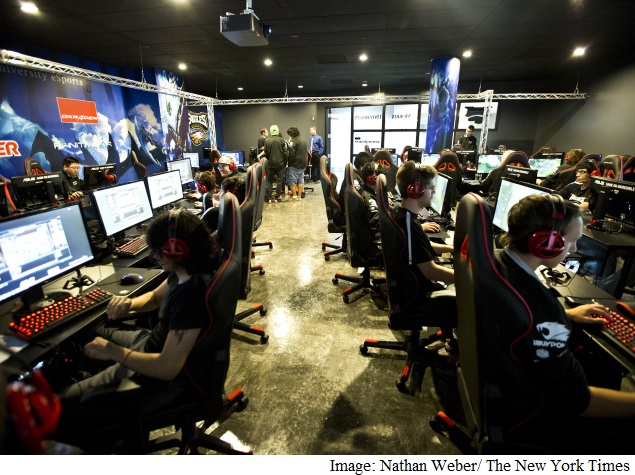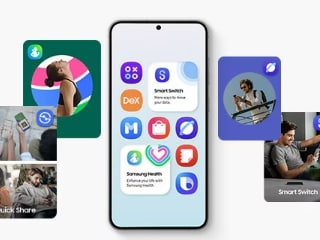- Home
- Games
- Games Features
- Colleges Embrace E Sports, With Teams and Scholarships
Colleges Embrace E-Sports, With Teams and Scholarships

"A lot of people stop me when I'm walking," said Tran, a 19-year-old sophomore, who speaks in quick and confident bursts. "They congratulate me."
But Tran is not a star on the football team, or a leader in student government. He is a top player on the school's competitive video game team, helping San Jose State claw its way to victory in June over California State University, Fullerton, in a tournament watched online by nearly 90,000 people. When the new school year started this fall, classmates' heads swiveled toward him when professors said his name during roll call.
"I thought that was pretty cool," Tran said.
Video game competitions, also known as e-sports, have taken off on campuses across the country, including Harvard and Florida State University. More than 10,000 students now play in the biggest college league, 4,400 more than last year and 4,600 more than the number of men who play on Division I college basketball teams.
The stakes keep climbing, too: Winning a big tournament can sometimes earn players several years' worth of tuition money. And in a possible sign of the future, the athletic department of Robert Morris University-Illinois in Chicago created an official video game team this fall, offering the same sort of scholarships given to athletes playing soccer, football and ice hockey.
While the college e-sports craze started as a grass-roots effort, game-makers have quickly swooped in, propelling the sharp rise in interest. The companies now underwrite scholarship prizes, offer team banners and provide organizational support, sensing a possible breeding ground for a new generation of superfans - people who not only play games but also consider them a spectator sport.
"Game developers are really waking up to the publicity power of these communities," said T.L. Taylor, an associate professor of comparative media studies at the Massachusetts Institute of Technology, who has studied e-sports.
Colleges, meanwhile, are often standing at arm's length. While e-sports groups are often sanctioned clubs, receiving practice spaces from their schools, the leagues and competitions have few of the student regulations governing traditional college sports, like grade-point minimums or time limits on practicing.
The rise in e-sports has been so abrupt, many schools have not determined what to make of it. Carter Henderson, a spokesman for the University of Washington's athletics program, said no one from the department was familiar enough with e-sports to discuss the topic. The National Collegiate Athletic Association, which oversees college athletics, said it had no comment about e-sports on campus.
Game companies say it is too early to predict how university administrations will become involved in e-sports.
"This is just how basketball was in the 1940s," said Christopher Wyatt, senior manager for North American publishing at Riot Games. "A lot of the structure and organization you see in more formal athletics, that groundwork is still being laid down here."
But it is unclear whether becoming a more formal part of a school would help or harm the growth of college e-sports. The time commitment required for serious competitive gaming could lead to concerns about whether e-sports leave enough time for academic study. In addition, formal recognition could diminish the autonomy that companies and teams have on campuses, bringing about rules like Title IX, the gender equity law.
About the possibility of more official recognition, Taylor said, "I don't think collegiate e-sports players are unified in any way that this is a good thing."
For game developers, however, the lure of being on campus is simple.
"We think that's where a lot of our players are," said Michael Morhaime, the chief executive and co-founder of Blizzard Entertainment, which develops and publishes entertainment software.
Last February, Riot Games hosted its first North American Collegiate Championship, something like the Final Four for "League of Legends," Riot's popular online battle game. A team of five students from the University of Washington won in front of a roaring audience at an e-sports studio that Riot operates in Manhattan Beach, California, with another 169,000 people watching online at the tournament's peak.
The prize: $7,500 (roughly Rs. 4.5 lakhs) in scholarship money for each team member.
Riot recently announced that first-place winnings at the next championship, to be held in the spring, will rise to $30,000 (roughly Rs. 18 lakhs), enough to pay for about three years of in-state tuition at the University of Washington.
"A lot more people than I expected came forward and said, 'I'd like to try out for the team,'" said Jackson Brown, the manager of the University of Washington's team, the Purple Caster Minions.
The growth of competitive gaming at colleges mirrors the broader rise of e-sports as entertainment. A thriving international professional e-sports circuit routinely draws tens of thousands of spectators to stadiums for competitions, with millions more viewers online. Top prizes for some events are now in the millions of dollars. Twitch, a video streaming service that made its name broadcasting e-sport matches, was acquired this year for close to $1 billion (roughly Rs. 6,190 crores) by Amazon.
The college scene is largely organized around the Collegiate StarLeague, which started at Princeton in 2009 and is the biggest college league. The organization is now active at 450 schools, up from 260 last year, according to Duran Parsi, the head of the league. Many of those players also participate in matches organized by another collegiate league, IvyLoL. Large West Coast schools like the University of Washington and University of British Columbia tend to dominate the competitions.
The money that game companies are pouring into the college scene has persuaded many students to become much more serious about e-sports. College scholarships from corporations, including Coca-Cola, Ford and Google, have been around for decades, usually to encourage students to enter a particular field, like engineering. The money that game companies are giving to students, in contrast, is meant to deepen the companies' relationship with a whole generation of players, one that is inseparable from their products.
Today, most professional players skip or delay college, because the college-age years are considered the prime period for players in the big leagues. Playing at the professional level requires far too much time for practice and travel to tournaments to allow them to also attend school.
Conan Liu, a student at Berkeley, took a year off from school to play "StarCraft II" professionally after his school team won the Azubu championship. Liu returned to school this fall to focus on pre-med studies because he did not perform as well as he had hoped in the pros. While even bench warmers in the National Basketball Association make more than $500,000 a year, the same is not true of professional gamers.
"You have to really be at the top, top to make a nice living," Liu said.
Game companies and collegiate league organizers predict that college e-sports could become a pipeline for the growing professional circuit. Game companies say they are awarding scholarship money at college tournaments, rather than unrestricted cash prizes, to give students an incentive to continue their studies.
"We really want e-sports to become as ingrained in the academic environment as anything else - speech competitions, football competitions," said Tyler Rosen, president of The e-Sports Association, which helps organize college events with the financial support of Blizzard Entertainment.
A test of what happens when schools embrace e-sports started recently at Robert Morris University-Illinois. The first 35 students to receive athletic scholarships under the school's new e-sports program began training this fall in a room decked out with jet black walls, mood lighting and leather gamer chairs with red piping.
The students, all "League of Legends" players, are getting up to 50 percent of the price of tuition and room and board, which runs about $39,000 a year, according to Kurt Melcher, the university's associate athletic director. Melcher said he had received more than half a dozen calls from athletic directors at other universities who are interested in incorporating e-sports into their programs.
The idea came to Melcher, a gamer, this year after he started reading about the Collegiate StarLeague. A conversation with his wife dispelled any doubts he had about awarding athletic scholarships to gamers.
Melcher said his wife asked, "Why should it only be given to some kid who can put a ball into a hole?"
© 2014 New York Times News Service
Catch the latest from the Consumer Electronics Show on Gadgets 360, at our CES 2026 hub.
Related Stories
- Samsung Galaxy Unpacked 2025
- ChatGPT
- Redmi Note 14 Pro+
- iPhone 16
- Apple Vision Pro
- Oneplus 12
- OnePlus Nord CE 3 Lite 5G
- iPhone 13
- Xiaomi 14 Pro
- Oppo Find N3
- Tecno Spark Go (2023)
- Realme V30
- Best Phones Under 25000
- Samsung Galaxy S24 Series
- Cryptocurrency
- iQoo 12
- Samsung Galaxy S24 Ultra
- Giottus
- Samsung Galaxy Z Flip 5
- Apple 'Scary Fast'
- Housefull 5
- GoPro Hero 12 Black Review
- Invincible Season 2
- JioGlass
- HD Ready TV
- Laptop Under 50000
- Smartwatch Under 10000
- Latest Mobile Phones
- Compare Phones
- OPPO A6c
- Samsung Galaxy A07 5G
- Vivo Y500i
- OnePlus Turbo 6V
- OnePlus Turbo 6
- Itel Zeno 20 Max
- OPPO Reno 15 Pro Mini 5G
- Poco M8 Pro 5G
- Lenovo Yoga Slim 7x (2025)
- Lenovo Yoga Slim 7a
- Realme Pad 3
- OPPO Pad Air 5
- Garmin Quatix 8 Pro
- NoiseFit Pro 6R
- Haier H5E Series
- Acerpure Nitro Z Series 100-inch QLED TV
- Asus ROG Ally
- Nintendo Switch Lite
- Haier 1.6 Ton 5 Star Inverter Split AC (HSU19G-MZAID5BN-INV)
- Haier 1.6 Ton 5 Star Inverter Split AC (HSU19G-MZAIM5BN-INV)
















